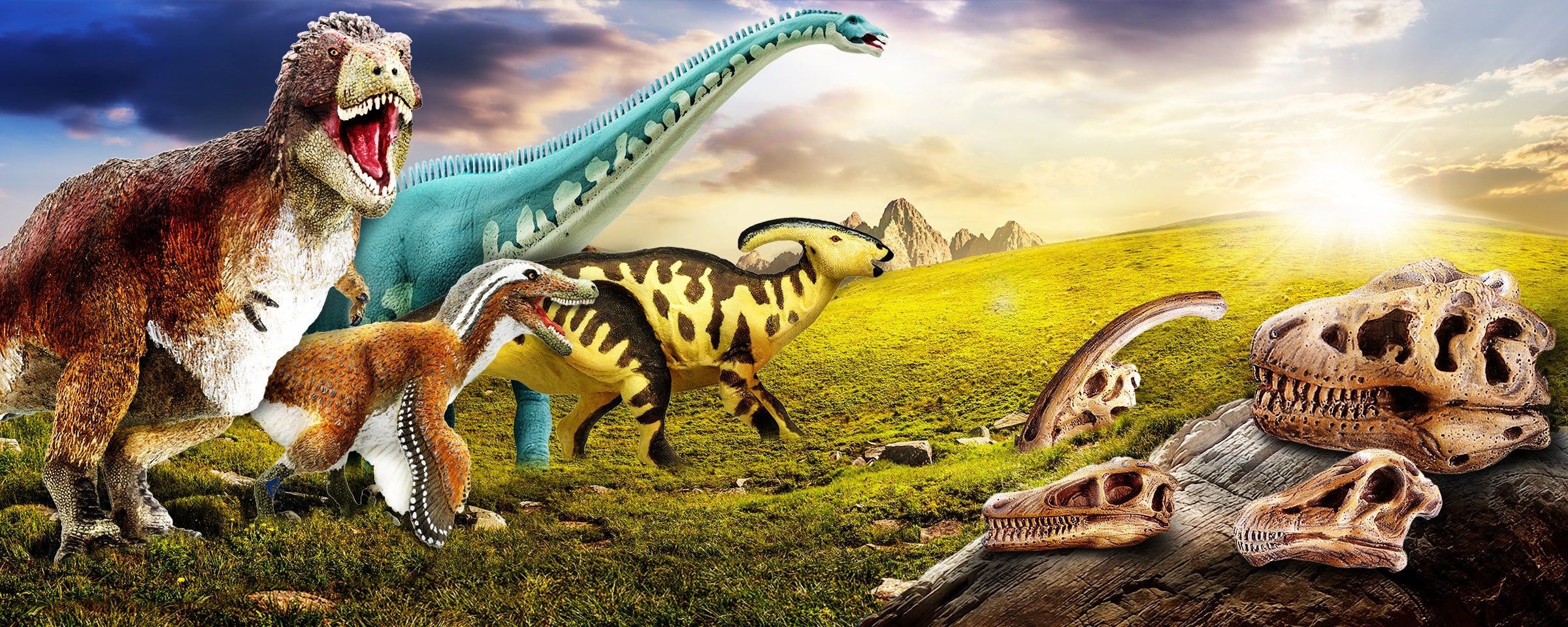The dinosaur toys you can buy right here on our website are cool, but the creatures they’re based on are even cooler. Dinosaurs lived millions of years ago, right here on Earth! Back then, the world was a very different place, separated into a few different time periods. Today we’re going to cover three of those time periods and learn how they were different from one another. We’ll start with the Triassic period, which began just 250 million years ago!
The Triassic Period - The Dawn of the Dinosaurs
Though there were many periods before the Triassic period, they did not include dinosaurs, so for the purposes of this blog here's where we'll start. It was a turbulent time as the Earth was recovering from the Permian extinction – an event that caused the destruction of two thirds of the terrestrial species on the Earth’s surface. While this was essentially an evolutionary restart, there is a lot to like about this period, especially when you consider it saw the introduction of archosaurs, pterosaurs, and early relatives of crocodiles. Somewhere along the way, it gave way to the therapsids, which gave rise to the first real mammals.
During the Triassic time period, the continents of the Earth were conjoined, forming the landmass of Pangaea. The ocean around this supercontinent was known as Panthalassa, and unlike today, there were no polar ice caps. Instead, we had a hot, dry atmosphere, with temperatures likely well over 100 degrees Fahrenheit – hardly livable for human beings!
It all came to an end eventually, though we aren’t quite sure what caused the Triassic extinction event. There is a strong chance that it was the product of volcanic eruptions, but it may also have been global cooling or even a meteor. In any case, this extinction-level event gave way to the Jurassic period, which you likely know from a popular series of movies. Reality, however, is a bit different.
The Jurassic Period - Not the Park You Were Expecting
The movie series “Jurassic Park” was pretty exciting, but it got one thing wrong: the time period. Let’s be honest, the name sounds cool, but many the dinosaurs shown during the movie actually lived in the later Cretaceous period. You can’t blame them; Cretaceous Park doesn’t sound quite so exciting, does it? Still, the Jurassic period was when we began to see much larger dinosaurs, including the first large sauropods and theropods.
It was in the Jurassic period that Pangaea began to break apart, and it split into two large pieces. The resulting continents are referred to as Gondwana, the southern landmass, and Laurasia, the northern landmass. These two continents hosted a hot, sticky environment with constant rainfall, so you can imagine that it was covered with dense vegetation.
As for the dinosaurs of the Jurassic period, most of them evolved into the Brachiosaurus and the Diplodocus. There were also theropod dinosaurs, such as Ceratosaurus, and the much larger Allosaurus.
Along with dinosaurs, the Jurassic period gave birth to more advanced mammals, most of them mouse-sized and nesting in trees, where it was safe. Finally, near the end of the Jurassic period, the first prehistoric birds had likely evolved, and it is believed that many of today’s birds are descendants of the Cretaceous period.
The Cretaceous Period - The OTHER Jurassic Period
When you think about most popular dinosaurs, this is likely the time period that most of them came from. While the Jurassic has its share of stars, the real dino-celebs arrived closer to the end. Instead of an extinction level event, the Cretaceous period began when dinosaurs reached the height of their diversity. Here we would see creatures like the lumbering Tyrannosaurus rex, the quick and slender Velociraptor, and the peaceful but formidable Triceratops. It is also from here that most of our dinosaur toys for kids come from.
At the opening of the Cretaceous period, Pangaea continued to break up, finally beginning to form the modern North and South America continents along with Europe, Asia, and India. This was yet another hot period of time, but for a change, we would see rising sea levels and lots of swamp development. Thick forests dominated the landscape, and the dinosaurs did well for a time, but it was doomed to fail.
The Cretaceous extinction event came with a meteor impact, occurring on the Yucatan Peninsula. This resulted in massive dust clouds that blotted out the sun, destroying vegetation, and ultimately causing the deaths of many dinosaurs that fed on that vegetation. With the extinction of most of the larger dinosaurs, the path for the development of mammals was clear.
But it's not an entirely sad story! Some dinosaurs did indeed survive this mass extinction event. They're still around today, and we know them as our fine feathered friends, the birds!
Dinosaur Toys for Boys and Girls Represent a Living History
When you invest your money in educational dinosaur toys, you’re giving children a chance to really experience prehistoric history, even through the power of play. In the early years, they may just play, but it could open them up to ask questions later, and research these mighty creatures on their own. Plant the seeds of curiosity with the best dinosaur toys today and watch it bloom.





